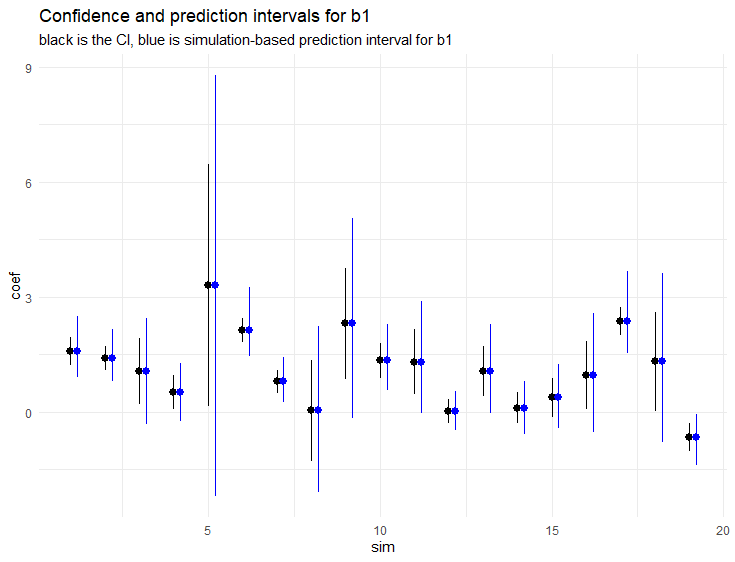Problem statement:
I am using a simple linear regression with outcome $y$ and single predictor $x$ of the form:
$$ y_i \sim N(\mu_i, \sigma) \\ \mu_i = \beta_0 + \beta_1x_i $$
I assume fitting $\beta_0, \beta_1$ with maximum likelihoood (although if other method works better for the purpose of this question, I can use that). Then, I observe a new set of outcomes $\bar{y}$ for a (known) new set of predictors $\bar{x}$ which I assume come from the same process. I then assume a regression is fitted independently to $\bar{x}, \bar{y}$ obtaining $\bar{\beta}_0, \bar{\beta}_1$.
Is there an analytical way to use the original fit to get something like a "prediction interval" for $\bar\beta_1$? I am looking for an interval with the expected coverage properties for $\bar\beta_1$ - the estimate of the slope from $\bar{x}, \bar{y}$. I assume this is going to be noticeably wider than the confidence interval as there's the additional uncertainty arising from sampling $\bar{y}$ and constructing the estimate based on those samples.
I could obviously use simulations to obtain that interval, but I am curious if there is a more elegant way.
Background:
I am attempting to do something akin to cross validation for testing the extent that each of a set of possible summaries is "reproducible" - having $N$ replicates, intuitively, a summary is good, if summarising $N - K$ replicates of the experiment lets me predict the summary the remaining $K$ replicates well. One of the summaries I am experimenting with is a slope from a regression model, so I'd like to develop the expected prediction interval if the model was actually capturing the data well.
Code example:
The following code shows the problem and solution with simulations in R.
In each simulation, I am trying to use the linear fit to $x,y$ to construct an interval that would contain $\bar{\beta}_1$ in 95% of cases. I use the confidence interval and then I use simulations to construct a "prediction" interval.
x <- rep(0:5, times = 4)
xbar <- rep(0:5, times = 2)
N_sims <- 100
#Pre-allocate
y <- matrix(NA_real_, nrow = N_sims, ncol = length(x))
ybar <- matrix(NA_real_, nrow = N_sims, ncol = length(xbar))
b1 <- numeric(N_sims)
b1ci <- matrix(NA_real_, nrow = N_sims, ncol = 2)
b1bar <- numeric(N_sims)
b1pred_sim <- matrix(NA_real_, nrow = N_sims, ncol = 2)
for(i in 1:N_sims) {
# Choose the true values randomly
# The results are quite similar whether I choose
# those separately for each simulation or
# once at the begining of the script
true_b0 <- 1 + rnorm(1)
true_b1 <- 0.5 + rnorm(1)
true_sigma <- 1 + rlnorm(1)
y_ <- rnorm(length(x), true_b0 + x * true_b1, sd = true_sigma)
y[i,] <- y_
fit <- lm(y_ ~ x)
b1[i] <- coef(fit)["x"]
b1ci[i,] <- confint(fit)["x",]
## Calculate the prediction interval with simulations
N_inner_sims <- 1000
sims_b1bar <- numeric(N_inner_sims)
for(j in 1:N_inner_sims) {
coef_sim_norm <- mvtnorm::rmvnorm(1, coef(fit), vcov(fit))
# Transform to T distribution
dof <- length(x) - 2
coef_sim <- coef_sim_norm / sqrt(rchisq(2, dof) / dof)
ysim <- rnorm(length(xbar), coef_sim[1] + xbar * coef_sim[2], sd = sigma(fit))
fitsim <- lm(ysim ~ xbar)
sims_b1bar[j] <- coef(fitsim)["xbar"]
}
b1pred_sim[i,] <- quantile(sims_b1bar, c(0.025,0.975))
## Actually fit the new data
ybar_ <- rnorm(length(xbar), true_b0 + xbar * true_b1, sd = true_sigma)
ybar[i,] <- ybar_
fitbar <- lm(ybar_ ~ xbar)
b1bar[i] <- coef(fitbar)["xbar"]
}
cat("Coverage CI: ", mean(b1bar >= b1ci[,1] & b1bar <= b1ci[,2]))
cat("Coverage prediction - sims: ",
mean(b1bar >= b1pred_sim[,1] & b1bar <= b1pred_sim[,2]))
Due to the simulations this is quite slow, but a typical result is something like:
Coverage CI: 0.81
Coverage prediction - sims: 0.96
so CI is too narrow while the simulations appear (at least approxiamtely) well calibrated. So the question is if I can get something like b1pred_sim analytically. Note that b1pred_sim is just appropriately widened CI:

